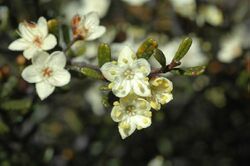Biology:Phebalium lepidotum
| Phebalium lepidotum | |
|---|---|

| |
| In Australian National Botanic Gardens | |
| Scientific classification Error creating thumbnail: Unable to save thumbnail to destination
| |
| Kingdom: | Plantae |
| Clade: | Tracheophytes |
| Clade: | Angiosperms |
| Clade: | Eudicots |
| Clade: | Rosids |
| Order: | Sapindales |
| Family: | Rutaceae |
| Genus: | Phebalium |
| Species: | P. lepidotum
|
| Binomial name | |
| Phebalium lepidotum (Turcz.) Paul G.Wilson[1]
| |
| Synonyms[1] | |
| |
Phebalium lepidotum is a species of rounded shrub that is endemic to Western Australia. It has scaly branchlets, leathery, narrow oblong leaves and white to cream-coloured flowers arranged in umbels of between three and six on the ends of branchlets.
Description
Phebalium lepidotum is a rounded slender shrub that typically grows to a height of 0.45–1.5 m (1 ft 6 in–4 ft 11 in). Its branchlets are slightly glandular-warty and covered with scales. The leaves are leathery, narrow oblong, 5–15 mm (0.20–0.59 in) long and 1.5–2 mm (0.059–0.079 in) wide on a short petiole, glabrous on the upper surface and covered with silvery scales on the lower surface. The flowers are white or cream-coloured and borne in umbels of between three and six, each flower on a thin pedicel about 5 mm (0.20 in) long. The five sepals are about 1.5 mm (0.059 in) long, joined for half their length and covered with rust-coloured scales on the outside. The petals are broadly elliptical, 4–5 mm (0.16–0.20 in) long and 3–3.5 mm (0.12–0.14 in) wide, covered with rust-coloured scales on the back. Flowering occurs from August to November.[2][3][4]
Taxonomy
This species was first formally described in 1863 by Nikolai Turczaninow and given the name Boronia lepidota in the journal Bulletin de la Société Impériale des Naturalistes de Moscou, from specimens collected by James Drummond.[5][6] In 1970, Paul G. Wilson changed the name to Phebalium lepidotum, publishing the change in the journal Nuytsia.[7]
Distribution
Phebalium lepidotum is found between Merredin, Zanthus and the south coast of Western Australia.[2][3]
Conservation status
This phebalium is classified as "not threatened" by the Government of Western Australia Department of Parks and Wildlife.[2]
References
- ↑ 1.0 1.1 "Phebalium lepidotum". Australian Plant Census. https://biodiversity.org.au/nsl/services/apc-format/display/82422. Retrieved 19 June 2020.
- ↑ 2.0 2.1 2.2 "Phebalium lepidotum". FloraBase. Western Australian Government Department of Parks and Wildlife. https://florabase.dpaw.wa.gov.au/browse/profile/4501.
- ↑ 3.0 3.1 Wilson, Paul G.. "Phebalium lepidotum". Australian Biological Resources Study, Department of Agriculture, Water and the Environment, Canberra. https://profiles.ala.org.au/opus/foa/profile/Phebalium%20lepidotum. Retrieved 19 June 2020.
- ↑ Wilson, Paul G. (1970). "A Taxonomic Revision of the Genera Crowea, Eriostemon and Phebalium (Rutaceae). Nuytsia 1(1):". Nuytsia 1 (1): 73. https://www.biodiversitylibrary.org/item/223300#page/79/mode/1up. Retrieved 19 June 2020.
- ↑ "Boronia lepidota". APNI. https://id.biodiversity.org.au/instance/apni/465563. Retrieved 19 June 2020.
- ↑ Turczaninow, Nikolai (1863). "Animadversiones ad catalogum primum et secundum harbarii universitatis charkoviensis (Amendments to the first and second lists of the herbarium of the University of Kharkiv". Bulletin de la Société impériale des naturalistes de Moscou 36 (1): 596. https://biodiversity.org.au/nsl/services/rest/name/apni/60466/api/apni-format. Retrieved 20 June 2020.
- ↑ "Phebalium lepidotum". APNI. https://id.biodiversity.org.au/instance/apni/499553. Retrieved 19 June 2020.
Wikidata ☰ Q15393516 entry
 |

